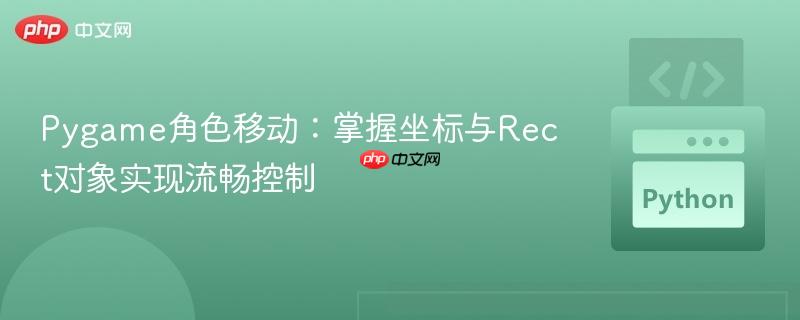
初学者在pygame中实现角色移动时,常遇到的问题是角色图像虽然被加载并显示,但按下按键后却不移动。这通常是因为只尝试在blit函数中改变位置,而没有在程序逻辑中实际更新角色的坐标变量。pygame中的图像绘制是“瞬时”的,每次循环都需要重新指定图像的位置。
要使角色移动,我们需要:
import pygame
pygame.init()
SCREEN_WIDTH = 800
SCREEN_HEIGHT = 600
screen = pygame.display.set_mode((SCREEN_WIDTH, SCREEN_HEIGHT))
pygame.display.set_caption("基本角色移动")
# 加载角色图像,并初始化其初始位置
# 假设 'Character.png' 存在,或者使用一个简单的矩形代替
try:
player_image = pygame.image.load('Character.png')
except pygame.error:
# 如果没有图像文件,创建一个绿色矩形代替
player_image = pygame.Surface((50, 50))
player_image.fill((0, 255, 0)) # 绿色
player_x = 30
player_y = 300
move_speed = 5 # 角色移动速度
running = True
while running:
for event in pygame.event.get():
if event.type == pygame.QUIT:
running = False
# 检测按键状态
keys = pygame.key.get_pressed()
if keys[pygame.K_w]:
player_y -= move_speed # 按W键向上移动
if keys[pygame.K_s]:
player_y += move_speed # 按S键向下移动
if keys[pygame.K_a]:
player_x -= move_speed # 按A键向左移动
if keys[pygame.K_d]:
player_x += move_speed # 按D键向右移动
# 画面绘制
screen.fill((0, 0, 0)) # 填充背景为黑色
screen.blit(player_image, (player_x, player_y)) # 在新位置绘制角色
pygame.display.flip() # 更新整个屏幕显示
pygame.quit()在上述代码中,player_x和player_y变量存储了角色的当前位置。每次循环中,根据按键输入修改这些变量,然后用修改后的变量值来重新绘制角色。
pygame.Rect对象是Pygame中一个非常实用的工具,它不仅可以存储位置(x, y)和尺寸(width, height),还提供了许多方便的方法,例如碰撞检测。强烈建议在Pygame项目中使用Rect对象来管理所有游戏对象的几何属性。
import pygame
pygame.init()
SCREEN_WIDTH = 800
SCREEN_HEIGHT = 600
screen = pygame.display.set_mode((SCREEN_WIDTH, SCREEN_HEIGHT))
pygame.display.set_caption("使用Rect对象角色移动")
# 加载角色图像,并获取其Rect对象
try:
player_image = pygame.image.load('Character.png')
except pygame.error:
player_image = pygame.Surface((50, 50))
player_image.fill((0, 255, 0))
player_rect = player_image.get_rect() # 获取图像的Rect对象
player_rect.x = 30 # 设置Rect的x坐标
player_rect.y = 300 # 设置Rect的y坐标
move_speed = 5
running = True
while running:
for event in pygame.event.get():
if event.type == pygame.QUIT:
running = False
keys = pygame.key.get_pressed()
if keys[pygame.K_w]:
player_rect.y -= move_speed # 直接修改Rect的y坐标
if keys[pygame.K_s]:
player_rect.y += move_speed
if keys[pygame.K_a]:
player_rect.x -= move_speed
if keys[pygame.K_d]:
player_rect.x += move_speed
screen.fill((0, 0, 0))
screen.blit(player_image, player_rect) # 使用Rect对象进行绘制
pygame.display.flip()
pygame.quit()在这个例子中,我们直接修改player_rect对象的x和y属性,然后将整个player_rect对象传递给blit函数,Pygame会自动使用Rect的位置信息进行绘制。
一个健壮的Pygame程序需要一个结构良好的游戏循环,它通常包括以下几个阶段:
import pygame
import random
# --- 常量定义 ---
SCREEN_WIDTH = 800
SCREEN_HEIGHT = 600
PLAYER_SPEED = 5
FPS = 60 # 目标帧率
# --- Pygame初始化 ---
pygame.init()
screen = pygame.display.set_mode((SCREEN_WIDTH, SCREEN_HEIGHT))
pygame.display.set_caption("Pygame角色移动与碰撞检测")
clock = pygame.time.Clock() # 用于控制帧率
# --- 游戏对象设置 ---
# 玩家
player_image = pygame.Surface((30, 30))
player_image.fill('green') # 绿色矩形作为玩家
player_rect = player_image.get_rect()
player_rect.center = (SCREEN_WIDTH // 2, SCREEN_HEIGHT // 2) # 初始位置在屏幕中心
# 目标(苹果)
apple_image = pygame.Surface((20, 20))
apple_image.fill('red') # 红色矩形作为苹果
apple_rect = apple_image.get_rect()
# 随机放置苹果
apple_rect.x = random.randint(0, SCREEN_WIDTH - apple_rect.width)
apple_rect.y = random.randint(0, SCREEN_HEIGHT - apple_rect.height)
score = 0
running = True
# --- 游戏主循环 ---
while running:
# 1. 事件处理
for event in pygame.event.get():
if event.type == pygame.QUIT:
running = False
# 2. 状态更新
keys = pygame.key.get_pressed()
if keys[pygame.K_w]:
player_rect.y -= PLAYER_SPEED
if keys[pygame.K_s]:
player_rect.y += PLAYER_SPEED
if keys[pygame.K_a]:
player_rect.x -= PLAYER_SPEED
if keys[pygame.K_d]:
player_rect.x += PLAYER_SPEED
# 边界检查(可选,防止玩家移出屏幕)
player_rect.left = max(0, player_rect.left)
player_rect.right = min(SCREEN_WIDTH, player_rect.right)
player_rect.top = max(0, player_rect.top)
player_rect.bottom = min(SCREEN_HEIGHT, player_rect.bottom)
# 碰撞检测
if player_rect.colliderect(apple_rect):
score += 1
print(f"得分: {score}")
# 重新随机放置苹果
apple_rect.x = random.randint(0, SCREEN_WIDTH - apple_rect.width)
apple_rect.y = random.randint(0, SCREEN_HEIGHT - apple_rect.height)
# 3. 画面绘制
screen.fill((0, 0, 0)) # 填充背景
screen.blit(apple_image, apple_rect) # 绘制苹果
screen.blit(player_image, player_rect) # 绘制玩家
pygame.display.flip() # 更新整个屏幕显示
# 4. 帧率控制
clock.tick(FPS) # 限制游戏每秒运行的帧数
# --- 游戏结束 ---
pygame.quit()在Pygame中实现角色移动,核心在于:
通过掌握pygame.Rect对象的使用,您不仅能更简洁地管理游戏对象的位置和尺寸,还能轻松实现碰撞检测,为构建更复杂的Pygame游戏打下坚实的基础。
以上就是Pygame角色移动:掌握坐标与Rect对象实现流畅控制的详细内容,更多请关注php中文网其它相关文章!

每个人都需要一台速度更快、更稳定的 PC。随着时间的推移,垃圾文件、旧注册表数据和不必要的后台进程会占用资源并降低性能。幸运的是,许多工具可以让 Windows 保持平稳运行。




Copyright 2014-2025 https://www.php.cn/ All Rights Reserved | php.cn | 湘ICP备2023035733号